
Ed. Note: This post was updated February 10, 2014 to reflect the most recent data.
Data from the Bureau of Labor Statistics show that of the overall increase in employment since the Affordable Care Act became law, more than 9 out of 10 positions have been full-time.
The Affordable Care Act continues to improve the functioning of labor markets in a range of ways including helping to slow the growth of premiums, creating affordable new options for small businesses, reducing the “job lock” that can keep workers from taking the best job for them, and generally improving health outcomes and reducing absenteeism. We are already seeing tangible changes in affordability, including employer premium growth at less than one-third the rate of the late 1990s and early 2000s.
Businesses owners who are looking to take advantage of tax credits, and other benefits under the law aimed at making coverage more affordable are encouraged to visit Business.USA.gov/healthcare for more information.
Moreover, to date there is no economy-wide evidence that the employer responsibility requirement, which is scheduled to go into effect in 2015, has increased part-time employment. In fact, a range of labor market data shows that our patterns of part-time employment are typical given our current economic recovery. This finding was reinforced by a recent Congressional Budget Office (CBO) report, which concluded that there is “no compelling evidence that part-time employment has increased as a result of the ACA.” Five charts make five key points in this area:
1. Since the Affordable Care Act became law, the economy has created 6.5 million full-time jobs, while the number of part-time jobs has been essentially unchanged. Over the 46 months since the Affordable Care Act was signed into law, the number of employed people has increased by 6.4 million, reflecting a 6.5 million increase in the number of people with full-time jobs and a negligible decline in the number of people with part-time jobs. The net increase in employment over this period is therefore due entirely to an increase in full-time work.
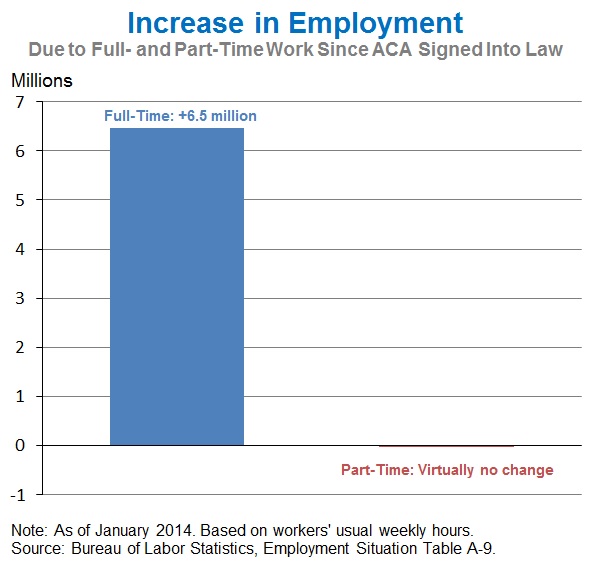
2. The mix of full-time and part-time employment has been typical for an economic recovery. A recent analysis by economists at the Federal Reserve Bank of San Francisco concluded that the share working part-time is in line with historical norms. After adjusting for the 1994 redesign of the Current Population Survey (which changed how part-time employment was measured), the authors found that the share working part-time is actually slightly below that observed in the early 1980s.
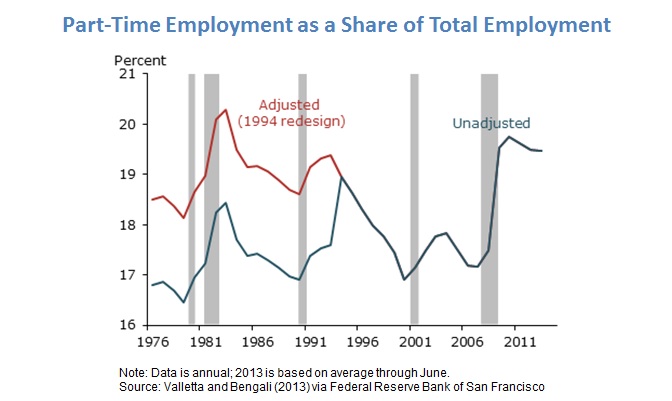
The authors noted, “We have shown that part-time work is not unusually high relative to levels observed in the past, most notably in the aftermath of the early 1980s recession.” The Congressional Budget Office’s recent report reached a similar conclusion.
3. The number of persons working part-time for involuntary “economic reasons” has fallen by 857,000 over the past twelve months. The number of federal government employees at work part-time for economic reasons has actually increased by 29,000, likely due at least in part to budget cuts resulting from sequestration. Thus, the number of persons working part-time for economic reasons in private sector and non-federal government positions is down by an even larger 886,000 (see chart, based on not seasonally adjusted data). In the spring of 2013, significant attention was paid to an increase in the number of persons working part-time for economic reasons. As these numbers indicate, this increase was transient and there has been no net increase over the last year, a reflection of the fact that these estimates can be volatile over short periods of time.
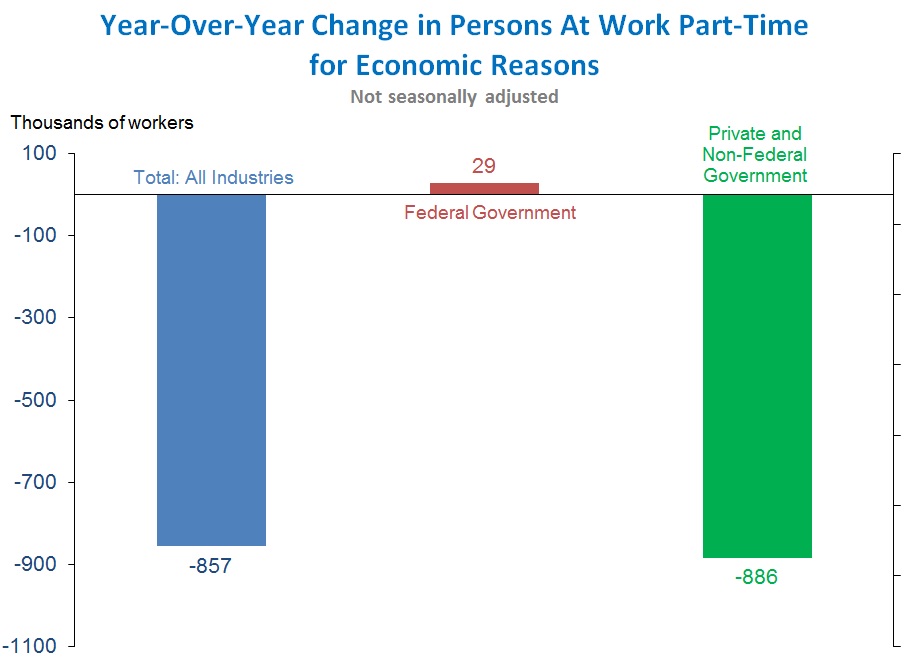
4. There is no systematic evidence that employers are shifting employees to just below 30 hours per week. CEA has analyzed the Current Population Survey to estimate worker hours in more narrow ranges than those published by the BLS. This analysis indicates that there has been no noticeable shift in employment just above or below the 30 hours per week threshold, a conclusion that has also been corroborated by outside analysts.
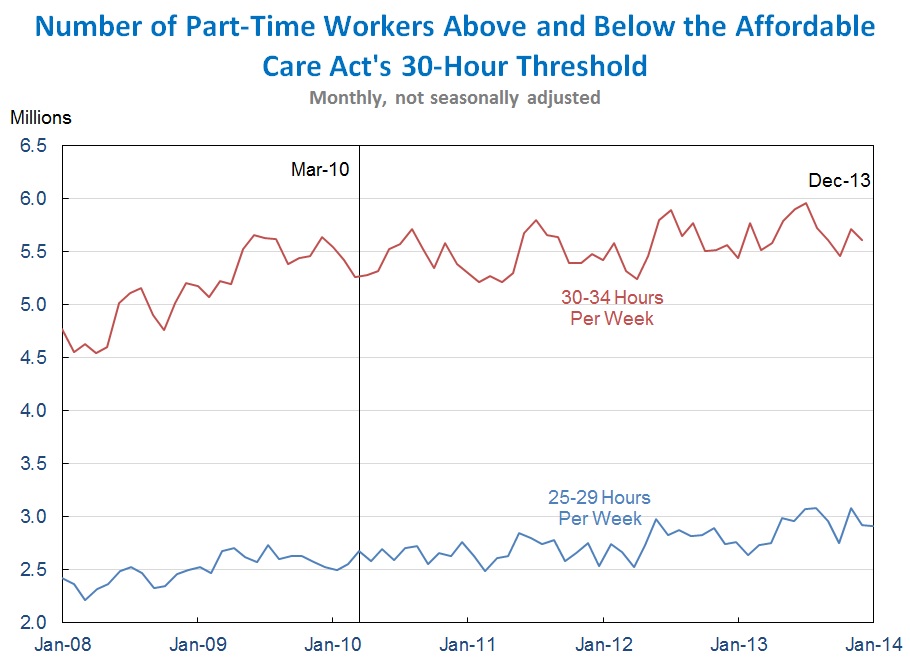
The data shown above are not seasonally adjusted. The ratio of persons working 30-34 hours to persons working 25-29 hours in December 2013 was similar to what it was the month Affordable Care Act was signed into law (1.93 in December 2013 vs. 1.96 in March 2010).
(Some have suggested that this comparison may be misleading because persons working between 29.5 and 30 hours per week may be counted as working 30 hours in these data. A simple way of addressing this concern is to exclude persons reported to work exactly 30 hours per week and compute the ratio of persons working 31-34 hours per week to persons working 25-29 hours per week. Due to the smaller number of workers involved, this ratio is more subject to sampling error and can be more volatile from month to month, but the results are broadly similar; the ratio stood at 0.66 in December 2013 versus 0.78 in March 2010, and it stood at exactly 0.78 as recently as September 2013.)
5. Employment growth in restaurants and bars has exceeded what you would predict from sales growth alone. The chart below plots the change in employment and the change in sales since March 2010 for a variety of sectors within the broad category of “retail and food services.” As one would expect, the points cluster around an upward sloping trend line, since sectors with faster sales growth are likely to have faster employment growth. The red dot representing restaurants and bars is well above the trend line, meaning that this sector has had much faster job growth than would be predicted based on its growth in sales.
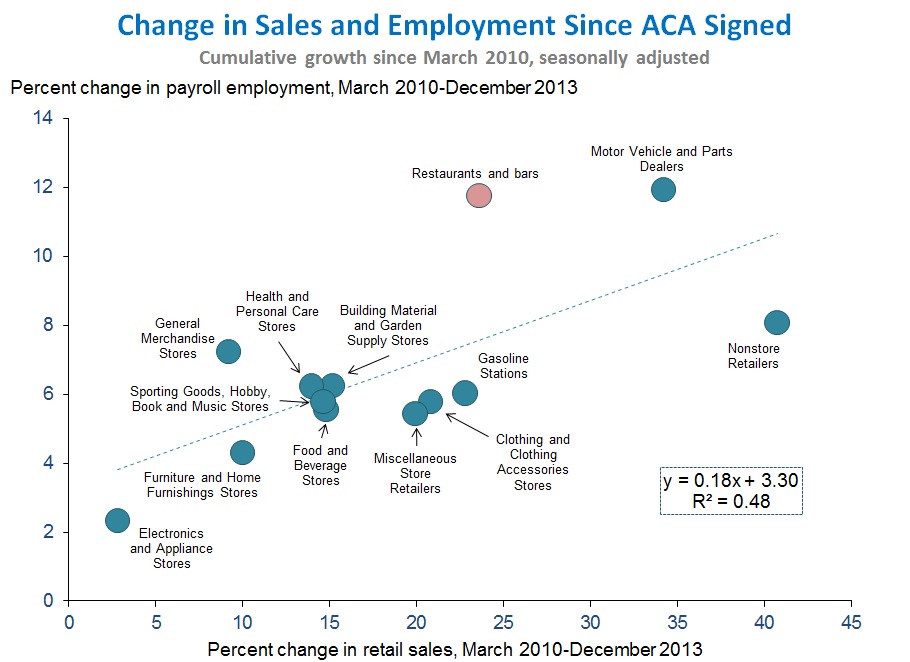
We highlight the change for restaurants for two reasons. First, many of the news stories claiming that the Affordable Care Act is hurting job growth focus on the restaurant industry. Second, restaurants have one of the lowest health insurance coverage rates of all the industries shown, and so are most likely to be affected by the employer responsibility provision when it goes into effect. But the data show that the potential impact of the provision clearly has so far not constrained the industry’s job growth. As of December 2013, the average workweek for restaurant and bar employees had fully recovered to its pre-recession level and is up 0.3 hours since the passage of the Affordable Care Act in March 2010.
In summary, the job data released today show that the vast majority of job growth since the Affordable Care Act became law is in full-time employment. Moreover, the Affordable Care Act has a number of measures that continue to improve the functioning of labor markets and the affordability of coverage for workers and businesses alike.

